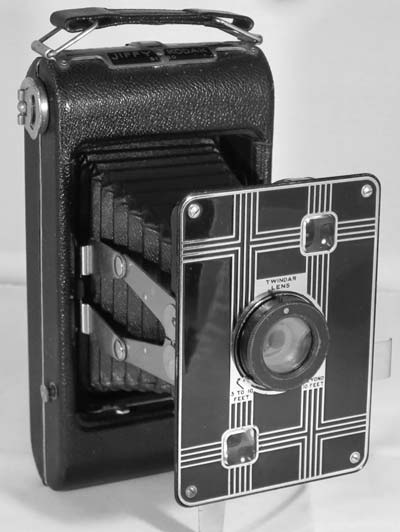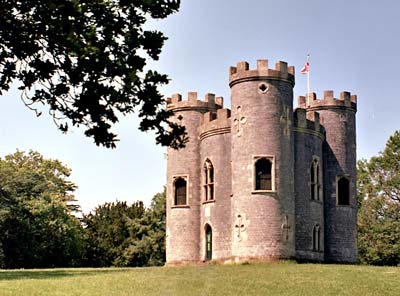Jiffy Kodak six 20
Specification

| Manufacturer | : | Kodak |
|---|---|---|
| Produced | : | 1933-1937 |
| Classification | : | Medium Format |
| Body Type | : | Folding Strut |
| Construction | : | Metal |
| Film Type | : | 620 |
| Film Width | : | 62mm |
| Image Size | : | 2¼ x 3¼ in |
| No. of Images | : | 8 |
| Lens Type | : | Twindar periscopic |
| Focus Type | : | Two position |
| Focal Length | : | 95mm |
| Focus Range | : | 10ft to inf portrait 5ft - 10ft. |
| Aperture Type | : | Multihole |
| Aperture | : | f/11, f/16, f/22 |
| Shutter Type | : | Rotary |
| Shutter Speeds | : | T, I*(1/45 sec) |
| Size Open (w x h x d) | : | 87 x 160 x 110 mm |
| Size Closed (w x h x d) | : | 87 x 160 x 38 mm |
| Weight | : | 535g |
| * Measured on this camera | ||
Art Deco Credentials
![]()
![]()
![]()
![]()
![]()
Iconic: Famous, well-known and celebrated
- Produced during the main Art Deco period.
- Etched metal front panel with lined geometric design.
- Chrome plated and enamel used for front panel.
- Symmetrical design.
- Chrome embellishment used throughout.
- Styled by Walter Dorwin Teague.
Description
The Jiffy Kodak Six-20 is a folding camera for 620 film made by Eastman Kodak Co. Ltd. Rochester from 1933 to 1937. It was styled by Walter Dorwin Teague. It has a Twindar periscopic lens with zone focusing; the only zones given are "5 TO 10 FEET" and "BEYOND 10 FEET". It has three selectable apertures, f/11, f/16 and f/22. It has two brilliant viewfinders in the pop out lens board, one for vertical and one for horizontal images. There is also a 616 film version of this called the Jiffy Kodak Six-16. The cameras are identical in design and functionality.
How to Use
This camera takes 620 film which is still available from selected photographic outlets. Although the actual film is the same as 120 film, the spools are different. The 620 spools are slightly shorter and have a smaller diameter. Do not use 120 film in this camera because it will jam and may snap. It is possible to cut down a spool of 120 film to fit or to re-spool some 120 film onto 620 spools in a darkroom or changing bag.
As the shutter speed is only 1/40s, it is advisable to use a tripod to get clear shake free images. However, holding it against a wall or other solid object would work as well. For quick snapshots, hold it firmly against your body.
If you don't want to bother with an exposure meter, follow the guide shown. It is based on the 'Sunny 16' rule. Film is so forgiving and will produce acceptable results even when overexposed by 2 or 3 stops or underexposed by 1 stop.
Of course, with modern films, the User Manual isn't particularly useful in terms of exposure.
This camera has three aperture settings of f/11, f16 and f/22 which are changed using a sliding tab.
The tables shown assumes the shutter speed is about 1/40s. If you are not sure about the light level, err on the side of overexposure - i.e. assume the lower light level.
The tables also assume that the sun is at least 30 degrees above the horizon - that's 10am - 5pm on a summers day in the UK.
Using ISO 100 film - shutter speed 1/40s
| Weather Conditions | Shadow Detail | Aperture | Exposure |
|---|---|---|---|
 Sunny SunnySnow/Sand | Dark with sharp edges | Tab Out f/22 | +1 Stop Overexposed Acceptable |
 Sunny Sunny | Distinct | Tab Out f/22 | Good |
 Slight Overcast Slight Overcast | Soft around edges | Tab Middle f/16 | Good |
 Overcast Overcast | Barely visible | Tab In f/11 | Good |
 Heavy Overcast Heavy Overcast | None | Tab In f/11 | -1 Stop Underexposed Acceptable |
 Open Shade Open Shade/Sunset | None | Tab In f/11 | -2 Stop Underexposed Unacceptable |
Photographs taken with this Camera
Images using Portra 160 120 respoolled onto 620 spool. Notice the light leak from a single pinhole - doh!



